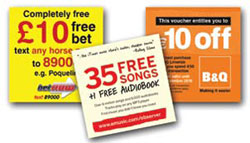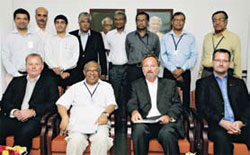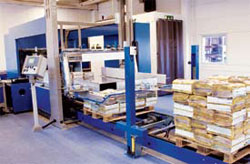|
Focus
Time to make newspaper mailrooms
sophisticated and upto optimum strength It is all apparent that with increasing circulations beyond a limit, the handling of newspapers manually in the post-press section becomes difficult, which ultimately causes to slow down the production output. The publishers having double width presses have undoubtedly no rescue, but to go for full automation in mailroom.
With printing machines running on speed of sixty to eighty thousand copies per hour, one can not depend on manual handling of newspapers. Actually, it is required not just handling the on-time printed newspapers, but also the inserts which are generally printed few hours before but need to go with the main newspapers duly inserted. There was a time (with some newspapers even today) when newspaper publishers would depend on the labour force of hawkers at the distribution point to execute insertions. But now with the paucity of time and increased cost of insertion demanded by hawkers community made the publishers to re-plan their strategies. And the solution obviously comes with automation. Definitely, installing the total automation costs a lot, but the publishers who are able to utilize that equipment fully and can ensure ROI are not shying away in deploying automation. That’s why over the years, mailroom segment at select newspaper establishments in India has been revamped replacing manual process into automation systems. Recent examples of such adoption can be counted as of: The Hindu, HT Media, The Times of India, Deccan Chronicle, Dinamalar, Sakal, ABP, Deccan Herald, DNA, Malayala Manorama and Mathrubhumi, etc. These newspaper establishments, while having multiple printing centers, have gone in automation for high print order locations, and the other locations still utilize alternate versions like belt conveyors and locally manufactured stackers, etc in their mailrooms.
While speaking to major suppliers in mailroom segment in India, we were able to gather their feedback in terms of installations made by them recently, new product launches, technologically developments and innovations created within this segment, which are described hereunder: Ferag: Latest new products launched by Ferag include Minisert and Tape Fix. “A cost effective alternative to manual inserting, Minisert is an entry level automated inserting machine capable of inserting at speed of 20,000 products per hour. While Tape Fix is an automated application of adhesive tape on the spine of collated products to be delivered as one packet. It has great utility in direct mailing where a cover jacket can be avoided due to this,” conveyed Kawal Arora from Ferag India. Talking about technological developments/up-gradation offered by Ferag in recent times, he mentioned ‘Navigator’ which is a Flying Frame technology based control server for the mailroom units, and provides advantages like ease to use, graphics oriented, high stability, wider connectivity, etc.
Ferag has recently installed their mailroom equipments at Mathrubhumi and The Times of India. “At Mathrubhumi in Kerala, we have completed four installation sites and two are under progress. One of the installed sites includes TKS double width press at Trivendrum. Ferag equipment includes – Premium single gripper conveyors UTR, Multistack stackers, top sheet printing, automated high speed online inserters, film wrappers and cross strappers. Total of twelve lines are to be installed with Mathrubhumi at their 10 printing plants. Besides, UTR, top sheet printers & applicators, MTS Multistack stackers, film wrappers and cross strappers are under installation at The Times of India in Kolkata and Chennai,” he mentioned. Muller Martini: As per P R Lakshminarayanan - general manager, Muller Martini India, “The latest new product launches by Muller Martini include: FlexLiner inserting system and FlexPack bundle building system. The new FlexLiner inserting system features the best price-performance ratio in the medium-sized market segment with high flexibility in terms of sizes, area of application, configuration and expansion, apart from increased user-friendliness due to ergonomically improved design and decentralized operation. Selective main product feeding can be expanded up to three feeding stations. With MPC (Mailroom Production Control), end products can be distributed according to region, zip code or even individual streets, making it possible to reach local advertising customers in a targeted manner.”
Talking about recent installations made by them in India, he mentioned, “Based on its positive experience of Muller Martini solutions at several of its other plants, The Hindu decided on a Newsveyor newspaper conveyor and a Listo stacker (which is ideal for thin to medium-thick products) from Muller Martini for its new plant in Calicut. The Listo stacker is the first stacker of this type in India. Top sheets are printed online and applied by hand. Afterwards the stacks are automatically film-wrapped and strapped. Since the Newsveyor has intermediate take-off and delivery stations, it is ideally suited to future expansions such as inserting machines. It means our longstanding customer The Hindu is optimally equipped for current and future production.” Muller Martini installed the first line of their solutions at Calicut facility of The Hindu earlier this year; and the installation of the second line at Madurai is expected to start from August 2012.” Recent innovation created through mailroom systems by them Muller Martini is online integration of saddle stitchers in the mailroom at DC Thomson, UK. “In order to make the best possible use of the capacity of the printing presses and the mailroom, DC Thomson (England) invested in a high-performance Tempo E220 saddle stitcher from Muller Martini with an integrated folder feeder for automatic loading from FlexiRoll. The Tempo E220 also has a folder feeder for high-gloss covers and an insert flat pile feeder for stitching in additional advertising supplements. The products stitched are trimmed using the NewsTrim, as are the products stitched on the web printing press. The all-in-one solution for folding, stitching in inserts, attaching high-gloss covers and cutting provides DC Thomson with maximum flexibility in the production of semi-commercials,” conveyed in a formal communication from Muller Martini. Schur/Newstech: “The latest product launches from Schur (Sweden) include: the A-955 inserter with speed of 35,000 copies per hour, the A-1455 high speed inserters for 45,000 copies per hour and the fully automatic palletizer for palletizing bundles for transport. Besides, new technology development comes in the form of a high-end software control system NOVA working on Windows-7 platform, to control the production and provide MIS of the mailroom for the management. The system controls each copy from the folder to the delivery point with many possibilities in in-line of inserting, single copy addressing, zoning for insert bundle production upto palletizing of bundle for transport,” informed, Roy Alex, managing director, Newstech (India) Private Limited, who have joint venture partnership with Schur. The recent installation in India by Schur through their Mumbai-based partner, Newstech (India) Private Limited happened at Malayala Manorama commencing their Alleppey site operations in January 2012. Being the largest single order worldwide for online inserting, the overall project is still going on. Presently the installation is going on at their Trivandrum facility for two press lines with tow inserters per press line. The equipment’s specs include: TGG 3200– gripper conveyor to bring the copies from the press folder to inserting; the A-955 inserter for the speed upto 35,000 copies per hour – two numbers per folder for two inserts each; from the inserter, the Gripper TGG 3200 picking up the copies and delivering to NTTS 300 stacker system manufactured in India, in our JV with Schur since 2004,” conveyed Alex. “The final bundle with the inserts, in bundle size as per distribution schedule requirement, is plastic wrapped, cross strapped and delivered to the truck loading systems. This combination of Schur Sweden imported equipment and the stack/pack-line made locally, offers customers, especially in the regional market a very cost effective solution for high speed inserting, yet with manual insert loading,” he added. The Newstech built mailroom is part of their local manufacturing programme. – Ajeet Singh New offerings from Pramod Engineering New Delhi-based Pramod Engineering introduced three different web-stackers including: standard web-stacker, compensating web-stacker with the delivery tray, and standard pride web-stacker with laser counter. These web-stackers have been designed to be compatible with any web-offset machine of any size and speed. The stacker is mobile and the conveyer is adjustable to fit any machine at any speed as it is equipped with a variable speed drive. The uniqueness of this machine is that it needs very minimal and compact space to perform – space of 84”x46”x36”. The machine weighs only 300 kg approx. Its jogger capacity of folded signatures is maximum of 310 mm x 500 mm and minimum of 105 mm x 140 mm. It is also economical on power consumption and needs 1.0 kw, 400-440 V, 3 phase, 50 Hz. nnn
|
|||||||||||


 MemoStick Kombi applications by Ferag.
MemoStick Kombi applications by Ferag.
 The Muller Martini Listo stacker is ideal for thin to
medium-thick newspaper products.
The Muller Martini Listo stacker is ideal for thin to
medium-thick newspaper products.
 Management teams of Malayala Manorama and Schur/Newstech.
Management teams of Malayala Manorama and Schur/Newstech.
 Schur compact palletiser.
Schur compact palletiser.